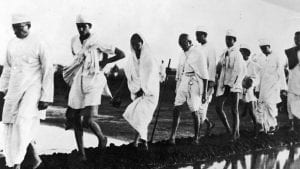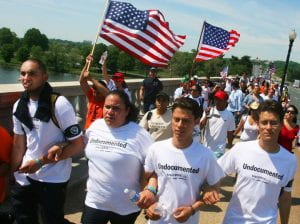Beautiful Trouble: The Salt March & Trail of Dreams
In February Pace NYC will be hosting the Debating for Democracy Conference, an annual event organized through the CCAR’s partnership with Project Pericles. This year we will be welcoming artist-activist trainers from Beautiful Trouble – a book and website “whose mission is to make grassroots movements more creative and more effective.” Every few weeks until the event CCAR staff members will be highlighting a case study from the book that they found particularly motivating. Up next is Student Projects Coordinator, Noelani Rivera!
Trekking:
There is nothing more natural and useful to us than walking. Little did you know that such an everyday thing is a tactic to help exercise your inner activist. Trekking has been a part of resistance movements for ages, Beautiful Trouble notes that extended treks and marches are not only a visible expression of a stance on issues, though also a “platform for outreach and mobilization.” Trek routes are chosen strategically to assure that the movement is seen by the public or specific individuals. This nonviolent tactic is often used to establish a connection between various locations with a common purpose and goal. Trekking can be representative of an alternative community, and highlight the issues facing that community specifically. An example of this would be a movement calling for workers of a company to march to the company headquarters to get their working conditions improved. This discourse community is facing this particular issue and calling for widespread members of it to come together to enact positive change. Because walking is physically laborious, therefore trekking can highlight the endurance and commitment a group has to its purpose. There have been various purposes fuelling past treks such as modeling alternative ways of living (alternative social structures), while others focus on the functions of the trek itself. The most well-known example of trekking is a “mass, many-day trek,” Gandhi’s Salt March.
The Indian National Congress decided that nonviolent protest, “satyagraha” was the tactic for their campaign for independence from British rule in Gujarat, India. Mahatma Gandhi, who was appointed to help develop an action plan, led the campaign during the 1930s and 1940s. In defiance of the Salt Act of 1882, prohibiting everyone except British nationals from collecting or producing salt, he proposed marching to the sea to do just that. Salt was a staple in the diet of many Indians. Beginning with approximately 80 men, and growing on the way, the 240-mile march had about 12,000 supporters by the time it reached the Indian Ocean. The power of the Raj, also known as the British Empire, was undermined as the march attracted more people. When presenting the march, Gandhi catered it towards the Indian public, framing it as a “long spiritual journey.” This was a traditional cultural practice called a “padyatra.” This gave the movement a sense of cultural resonance, offering more opportunity to expand the movement. While traveling across India, over a period of three years, Gandhi realized that he needed a “tangible manifestation” of the demand for independence. When people were able to hold the fruits of their labor. It brought the immediate feeling of and set the stage for India’s independence. He recognized that appealing to the masses, the lower classes, was at the benefit of all Indians.
A more recent example of trekking is the Trail of Dreams, a walk from Miami, Florida to Washington D.C. taking place from January 1st, 2010 to May 1st, 2010. Gaby Pacheco is an undocumented American, and immigrants rights leader, who walked 1,500 miles with three friends (Juan Rodriguez, Carlos Roa, and Felipe Matos) with the long-term goal to humanize the debate surrounding immigrants and combat the negative portrayals of immigrants within mainstream media. They aimed to influence Washington to alter a system that has failed undocumented community members. The group had four goals:
- Get President Obama to issue an executive action stopping the holding & deportations of students (for two years) and stop the removal proceedings of people whose immediate family are citizens.
- Have the Development, Relief and Education for Alien Minors (DREAM) act passed.
- For immigrant worker rights to be protected.
- Humane immigrant reform.
This is an example of the tactic of trekking being used because of its relation to the movement itself, since the movement addresses the predicaments faced by immigrants on their path to success in the United States. The group faced a multitude of physical challenges such as body aches, blisters, and one of the coldest winters. The group also faced backlash from other organizations such as the Ku klux Klan (KKK), targeting the group with intimidation tactics. While these were all valid and serious challenges, the biggest risk the group undertook was deportation as a result of being in contact with federal immigration authorities directly.
They aimed to inspire others across the U.S. through their personal anecdotes and stories of struggle. Beautiful Trouble beautifully sums up the movement’s impact by saying “The trek inspired a nation of DREAMers and allies to fight for the passage of the DREAM Act. which, while not yet passed into a law, remains within reach.”
Acts of trekking, including the Salt March and Trail of Dreams are inspiring examples of creative and powerful resistance!
Students interested in attending the Debating for Democracy Conference on February 28th should email emysogland@pace.edu for more information!
Sources:
https://www.nytimes.com/2019/11/12/us/daca-supreme-court.html
https://www.vox.com/2019/11/11/20954114/3-ways-supreme-court-daca-dreamers-trump
https://www.nytimes.com/2019/11/12/us/daca-supreme-court.html







